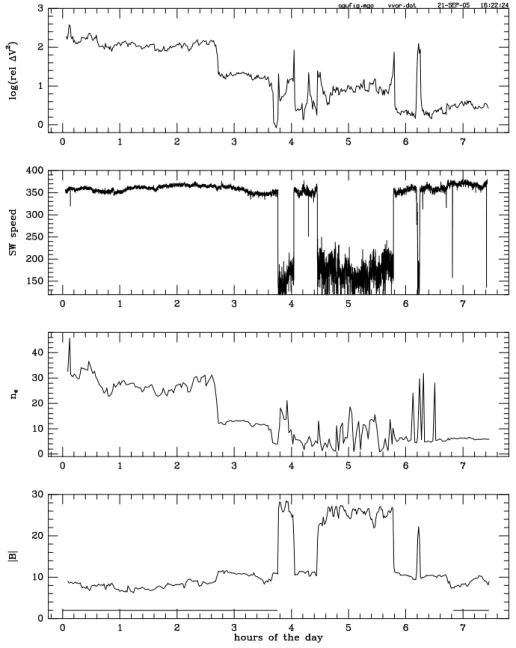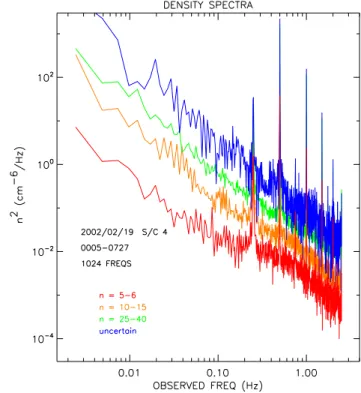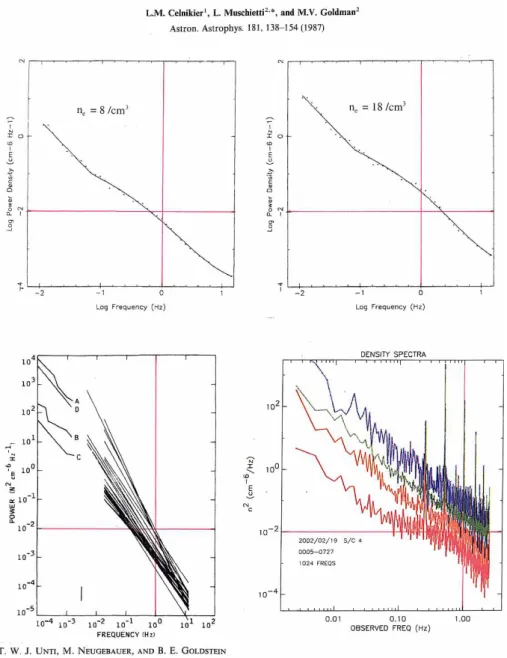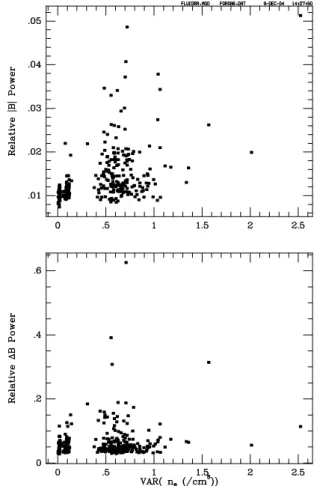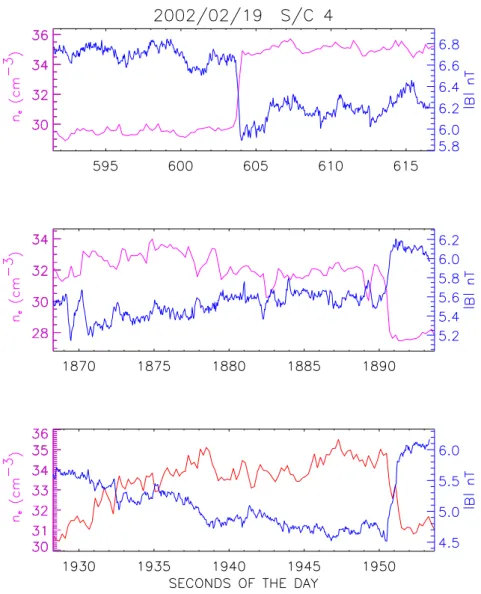HAL Id: hal-00318110
https://hal.archives-ouvertes.fr/hal-00318110
Submitted on 23 Dec 2005
HAL is a multi-disciplinary open access
archive for the deposit and dissemination of
sci-entific research documents, whether they are
pub-lished or not. The documents may come from
teaching and research institutions in France or
abroad, or from public or private research centers.
L’archive ouverte pluridisciplinaire HAL, est
destinée au dépôt et à la diffusion de documents
scientifiques de niveau recherche, publiés ou non,
émanant des établissements d’enseignement et de
recherche français ou étrangers, des laboratoires
publics ou privés.
Rapid density fluctuations in the solar wind
P. J. Kellogg, T. S. Horbury
To cite this version:
P. J. Kellogg, T. S. Horbury. Rapid density fluctuations in the solar wind. Annales Geophysicae,
European Geosciences Union, 2005, 23 (12), pp.3765-3773. �hal-00318110�
Annales Geophysicae, 23, 3765–3773, 2005 SRef-ID: 1432-0576/ag/2005-23-3765 © European Geosciences Union 2005
Annales
Geophysicae
Rapid density fluctuations in the solar wind
P. J. Kellogg1and T. S. Horbury2
1University of Minnesota, Minneapolis, MN, 55455, USA 2Imperial College, London, UK
Received: 10 February 2005 – Revised: 12 November 2005 – Accepted: 15 November 2005 – Published: 23 December 2005
Abstract. Electron density fluctuations (up to 2.5 Hz) in the
solar wind have been studied, using the EFW experiment on the Cluster spacecraft, which measures density through measurements of the biased probe potentials relative to the spacecraft. The density fluctuation spectra obtained from the EFW probe potential variations are compared to earlier, OGO 5, measurements of ion density fluctuations and ISEE measurements of electron density fluctuations, and are con-sistent with them. The electric fields corresponding to the electron density fluctuations are extremely small compared with what would be obtained if the electron fluctuations were not cancelled out by nearly equal ion density fluctuations. This is consistent with the nature of ion acoustic waves. In agreement with ISEE work, the fluctuations are proportional to the ambient density. Correlation with magnetic fluctua-tions is weak, essentially nonexistent during part of the pe-riod studied. This might be expected as magnetic fluctuations are known to be nearly incompressible, but even the corre-lation with fluctuations in the magnitude of B is very small. However, many structures which apparently are pressure bal-ance structures are found. Pressure balbal-ance structures are the nearly perpendicular propagation limit of ion acoustic waves. As ion acoustic waves are strongly damped in plasmas like the solar wind at least if the plasma is taken as Maxwellian, it has always been a puzzle as to why they are found there. We speculate that these waves are created by mode conversion from magnetic fluctuations, and may represent part of the dissipation process for these.
Keywords. Space plasma physics (Electrostatic structures;
Turbulence; Waves and instabilities)
1 Introduction
Solar Wind density fluctuations in the frequency domain above about 0.01 Hz have been little studied in situ since the 1980’s. They are important for several reasons. (1) Fluctuations in general must replace collisions to account for the validity of MHD, a theory which requires some pro-cess to maintain thermal quasi equilibrium, and for violation
Correspondence to: P. J. Kellogg
(kellogg@waves.space.umn.edu)
of the conservation of particle magnetic moment and the isotropy of the ion distributions (Kellogg, 2000), (2) Con-version of Langmuir waves to electromagnetic radiation is thought to involve interaction of the Langmuir waves with density ramps, (Kellogg, 1986; Yin and Ashour-Abdalla, 1999; Willes and Cairns, 2003; (3) density fluctuations play an important role in the propagation of radio waves in the so-lar wind and in near earth space (Lacombe et al., 1997 and references therein), and (4) most of our information about the solar corona inside of 0.3 AU comes from the study of this perturbation of radio signals by density fluctuations (e.g. Woo, 1978, 1995; Coles et al., 1991, 1992; Grall et al., 1996; Kojima et al., 1998).
2 Observations
Observations of plasma properties on the time scale near the spin rate are generally quite difficult with a spinning spacecraft. The four Cluster spacecraft are spinning, at 0.25 Hz, but the double probe system of the EFW experi-ment (Gustafsson et al., 1997) , which is used for this study, is designed to be relatively immune to the effects of changing angles to sunlight and to the solar wind. The probes of this system are 8-cm dia. spheres on the end of booms with a tip to tip distance of 88 m.
As the Cluster spacecraft do not go very far beyond the bow shock (to 19 RE), it is not easy to find extended periods when the spacecraft are in the free solar wind, that is, beyond the bow shock and not connected to it by magnetic field. The spacecraft normally only go beyond the bow shock during January–March of each year. A period from 00:03–07:27 UT on 19 February 2002 has been chosen. In Fig. 1 is shown the spacecraft orbit (heavy line) relative to a model bow shock together with a line of magnetic field at a certain time.
In Fig. 2 are shown some data relevant to the plasma sur-rounding the spacecraft. From bottom to top, the panels are magnitude of the magnetic field in nT from the FGM ex-periment (Balogh et al., 1997), the electron density taken from the Whisper plasma line, the solar wind speed from the CIS experiment, and the variance of the probe poten-tials. This last is a measure of the fluctuations of electron density. The Whisper experiment measures the spectrum of Langmuir oscillations in equilibrium with the quasi-thermal
3766 P. J. Kellogg and T. S. Horbury: Rapid density fluctuations in the solar wind
Fig. 1. Spacecraft position during the period chosen for this study, together with a line of magnetic field.
plasma, (Meyer-Vernet, 1979; Kellogg, 1981; Meyer-Vernet and Perche, 1989) which provides a measure of plasma den-sity which is relatively independent of spacecraft perturba-tions of the plasma, since the Langmuir waves at the lowest frequencies have wavelengths very long compared to the size of the disturbed region. When the spacecraft are in the fore-shock region, i.e. when there is a magnetic connection to the bow shock, the amplitude of the plasma line increases enor-mously, as the plasma is unstable to Langmuir waves in this case. This has been used, together with the occurrence of ion acoustic waves in the Whisper data, to decide whether there is connection to the bow shock and consequent disturbance of the plasma. During the period under study, the solar wind speed was relatively constant, at 335–360 km/s, so that the dynamic pressure of the solar wind depends mainly on den-sity. Early in the day, the density is about 25–30cm−3. At
02:45, there is a relatively abrupt drop in density to about 10 cm−3. Then at about 03:45 there is a further drop to about 4 cm−3. In response to this decreased dynamic pressure, the bow shock moves out and crosses the Clusters. The satel-lites remain in the magnetosheath behind the bow shock un-til about 04:00, reenter the magnetosheath about 04:25 and reemerge into the solar wind at about 05:50. Each of the bow shock crossings is shown by a peak in the variance of the probe potentials. There are bow shock crossings at 03:47, 04:03, 04:18, 05:48, 06:12 and 06:15. During the brief solar wind interval from 04:00 to 04:25, there seems to be some magnetic connection to the bow shock, so that this period is excluded from the study. After 05:50, the bow shock recedes earthward of the satellites, but the density is still lower than earlier, at about 6 cm−3, and remains low until about 07:27.
However, there is a magnetic connection to the bow shock until about 06:50, so that only the period from 06:50 to 07:27
has been used. After 07:27, there are some bow shock cross-ings, and some magnetic connections to the bow shock, and the Clusters are only in the free solar wind for shorter periods for the rest of the day. A heavy line in the lowest panel shows the periods used for this study.
3 Density vs. probe potential calibration
In a plasma, an isolated body assumes a potential such that currents to it are balanced. In the solar wind, the main cur-rents to an isolated body are photoelectron emission, which is the largest and constant, and plasma electron pickup. If these are the main contributions, then the body becomes positive to reduce the escape of photoelectrons, by an amount which varies with electron density and temperature. This variation may be reduced nearly to zero by supplying a bias current, in this case to the probes of the double probe sensors, which is constant and nearly balances the photoemission. In that case, the potential of the probe relative to the plasma is con-stant and small. Pedersen (1995) has shown that geometrical (Langmuir-Blodgett) effects reduce the importance of elec-tron temperature and that the potential of the satellite relative to such a biased probe may be used to measure the electron density.
The EFW experiment supplies such a bias current to the probes, and continuously measures the potential of the probes relative to the main body. We refer to these measure-ments as “probe potential”, but the probe potential relative to the plasma is small and what is of interest is the satellite potential. In the solar wind, the satellites are positive with re-spect to the plasma, more positive if the density is low. The measured probe potential then is negative and becomes more
P. J. Kellogg and T. S. Horbury: Rapid density fluctuations in the solar wind 3767
Fig. 2. Some data pertaining to the spacecraft ambiance.
negative as the density becomes smaller, which is convenient intuitively.
In Fig. 3 is shown a set of measurements of probe potential vs. the electron density as obtained from the plasma line as measured by the Whisper experiment (Decreau et al., 1997). It will be seen that the probe potential is a quite good measure of density. In this plot, the periods when Cluster was in the magnetosheath have been excluded. This technique does not work well at all in the magnetosheath, – the points obtained there fall far away from the rest. A. Pedersen (private com-munication) suggests that secondary emission by energetic electrons in the magnetosheath is responsible. Calibrations similar to these have been carried out by others, (Gustafs-son et al., 2001; Pedersen et al., 2001) but it was desired to do a calibration specifically for the conditions of this work. Separate calibrations were made for the various probes. The calibrations differ very slightly.
The curve shows a fit to the observations, a linear com-bination of three exponentials with different “temperatures” and coefficients, giving six parameters to be established.
4 Discussion of observations
It is apparent from Fig. 2 that the variance of the probe po-tentials is increased when the plasma density is increased. This is shown more clearly in Fig. 4, which shows the den-sity spectra in the regions of Fig. 2, separated according to ambient plasma density. The lowest spectrum (red) is the average of 5 spectra, based on 2048 samples, from the low-est density region, from 06:50 to 07:27 UT, where the aver-age density is about 5–6. The next (orange) is for the period 02:45–03:45 UT, where the average density is about 10–15. The green spectrum is for the period 00:05–02:45 where the
3768 P. J. Kellogg and T. S. Horbury: Rapid density fluctuations in the solar wind
Fig. 3. Calibration of probe voltage vs. density.
average density was 25–40. The highest spectrum (blue) is the average of 2 large spectra which seemed anomalous, one from the discontinuity at 02:45, the other from the beginning of the period, at 00:05 UT, where there is some uncertainty about connection to the bow shock. However, the spectra do not have the form of foreshock spectra and so have been in-cluded. In these plots, the spikes are harmonics of the spin frequency, are due to photoelectric effects, and are to be ig-nored.
Celnikier et al. (1987) were the first to find that the fluctu-ations are proportional to the density, and this extends their observation to somewhat higher density. In Fig. 5, the results of this technique are compared with earlier measurements of the spectrum of density fluctuations (Unti et al., 1973; Cel-nikier et al., 1983, 1987). A red line has been drawn at the same frequency and power in each of the plots to facil-itate comparison. It will be seen that the present technique yields results which are roughly comparable to the measure-ments of Unti et al. (1983, 1987) who measured ion density fluctuations with a Faraday cup experiment, and with Cel-nikier et al. (1983, 1987), who measured electron density us-ing varyus-ing phase shifts in a radio wave propagation experi-ment. These observers saw the flattening above 0.1 Hz which is clear in the two spectra at lowest density (red and orange), and Marsch and Tu (1990) have investigated it more com-pletely in Helios data. Here the two lowest densities show similar flattening, but the highest density (green) is well rep-resented by a single power law at f−1.37.
In Fig. 6, plots at a higher time resolution show the approx-imate proportionality of the “relative power”, vs. the square of plasma density averaged over the same 50 s interval. “Rel-ative power” means that the power has been calculated by summing the squares of the Fourier coefficients of the power
Fig. 4. Density fluctuations spectra in several density regimes.
spectrum weighted by an average spectrum. For the den-sity relative power, the average spectrum is taken to be the power law f−1.37. The result is then essentially the coeffi-cient of a spectral density fitted to the observed spectrum. This is so that all frequencies will be represented in the “rel-ative power”, and is used to reduce statistical fluctuation. If one simply calculates the variance of the time series, the de-scending spectrum means that the low frequency component determines the calculated power, and its statistical fluctuation is so large as to obscure the trends. In calculating relative power, the harmonics of the spin frequency, so prominent in Figs. 4 and 5, have been removed.
The density fluctuations do not seem to follow the mag-netic field fluctuations very well. In Fig. 7 are shown time sequence plots of the relative power in the magnetic field fluctuations and in the density fluctuations. Up to about 01:30 UT, there is some tendency to correlation, but then in the period 01:30–02:45, there is anticorrelation, rather. In Fig. 8 is shown a more conventional scatter plot of the corre-lation, or lack thereof. In this figure, the magnetic field fluc-tuations are calculated both as the sum of the relative powers in the vector components of B, and the relative power in the magnitude of B. For these “relative powers” of B, the aver-age spectrum has been taken to be a power law at f−(5/3).It would be expected that fluctuations of density would corre-late best with fluctuations of the magnitude, i.e. the com-pressible part. There is little correlation in either case. It will be seen that the relative power in B does not show the same dependence on plasma density as the density power does. But even within the regions of relatively constant ambient density, there is little correlation between the two. Note that
P. J. Kellogg and T. S. Horbury: Rapid density fluctuations in the solar wind 3769
Fig. 5. Comparison with earlier density spectrum measurements.
the period 00:00–01:30 UT corresponds to the highest den-sity, and these points are therefore the points to the right in the figures, since the fluctuations in density are largest then.
Conversely, however, some of the density fluctuations are accompanied by opposite fluctuations in the magnitude of B, which we assume are pressure balance fluctuations or tan-gential discontinuities. These are very rapid, some changes happening in 0.5 s or about 5 proton Larmor radii, and since the electron and ion temperatures are not available on the time scale required, this cannot be demonstrated with cer-tainty. But it seems reasonable. Several examples are shown in Fig. 9 In the first 1000 s of 19 February 2002, we iden-tified 30 of these. There were fewer, 7, in the next 1000 s, These are considerably more than the number of discontinu-ities found in studies of averaged data with a slower cadence,
which occur less than once in this time, on average one or two per hour (Smith, 1973; Tsurutani and Smith, 1979; Hor-bury and Balogh, 2001).
These electron densities must be nearly neutralized by ion densities, a characteristic of electrostatic waves in this low frequency range. If they were not neutralized, then the elec-tric field would be far larger than observed. As an order of magnitude calculation, we have, in Fourier space:
kE=−eφnTOT/φ0.
Assuming convection with the solar wind so that the ob-served frequency, f , is mainly Doppler shift, we have k = 2φf/Vsw ∼ 10−5
3770 P. J. Kellogg and T. S. Horbury: Rapid density fluctuations in the solar wind
Fig. 6. Dependence of density fluctuations on average density.
Fig. 7. Time series of relative power in magnetic and density
fluc-tuations.
and taking dn∼3×10−2/cm6Hz=3×1012/m6Hz, we would have:
E(k)2=(eδn/kφ0)2∼105(V/m)2.
The electrostatic part of the electric field, which will be the subject of future work, does not exceed about 10−9(V/m)2/Hz, giving a ratio of greater than 1013 for the ratio of electron density to charge density divided by e.
This ratio is in rough concordance with expectations for electrostatic waves in which the electrons are isothermal,
Fig. 8. Scatter plot of the relative power in magnetic and density
fluctuations. The lower panel shows the sum of the powers in the three components, the upper shows power in |B|.
such as ion acoustic waves with k not too close to perpen-dicular to B:
n = n0exp(eφ/kT)
δne=n(e/kT)δφ
which leads to a ratio
δne/δnTOT=k2l2D,
where lD is the debye length, here about 10 m, so that
klD∼10−4, and the ratio of the squares of the density
fluc-tuations as above is about 10−16. A similar very small ratio
is also expected for kinetic Alfv´en waves at some angles of propagation.
5 Summary and Conclusions
We feel that we have verified the probe voltage technique as a measure of electron density fluctuations in the solar wind. There has been, at least for one of us (PJK), always a sus-picion that electron temperature might play a greater role than it apparently does. However, the probe voltage curve of
P. J. Kellogg and T. S. Horbury: Rapid density fluctuations in the solar wind 3771
Fig. 9. Probable pressure balance fluctuations.
Fig. 3 shows very little of the scatter that might indicate de-pendence on electron temperature. The measurements agree with past measurements as well as can be ascertained. Hence we feel that this technique, which offers the possibility of ex-tension to higher frequencies in the future, is validated for the study of fluctuations of density.
A second, physically more important, point is that the den-sity fluctuations represent a plasma mode which is different from the magnetic fluctuations, and which seems not to be included in the frequently used incompressible MHD theory. Evidence points to density fluctuations as being somewhat like ion acoustic waves, though the evidence is not suffi-ciently strong to rule out the other mode with strong density fluctuations, the kinetic Alfv´en mode at near perpendicular propagation, and certainly not strong enough to rule out a mixture. The electron density fluctuations must be neutral-ized by ion density fluctuations to high accuracy, as are ion acoustic waves. They are not well correlated with magnetic field fluctuations on the whole, but some fluctuations seem to be pressure balance fluctuations, which do involve magnetic
field. This does not contradict the identification with ion acoustic waves, as pressure balance fluctuations are the per-pendicular propagation limit of ion acoustic waves. Their power spectrum f−4/3is flatter than that of magnetic fluctu-ations, which are f−5/3 in the lower part of the frequency range studied here, and steeper in the higher part (Leamon et al., 1998, 1999). The power in fluctuations seems to be proportional to the square of the ambient plasma density, in agreement with the observations of Celnikier et al. (1987).
It appears that density fluctuations are relatively indepen-dent of magnetic fluctuations. They are even uncorrelated with fluctuations in the magnitude of B, the usual indicator of compressible fluctuations, so that they give another win-dow which can be used to study the turbulent solar wind.
Ion acoustic waves should be heavily damped if the dis-tribution functions of the particles are “normal” Maxwellian distributions. Yet ion acoustic waves do occur frequently in the kHz range, where they are usually detected through their electric fields. In that range, it is believed that the waves grow on occasionally occurring unstable distributions. The
3772 P. J. Kellogg and T. S. Horbury: Rapid density fluctuations in the solar wind
kHz waves are extremely intermittent, however, whereas the waves studied here are less so. It is likely that the two fre-quency ranges have different causes. As the solar wind is very turbulent, it is probable that there is a lot of mode con-version as well as frequency and wave number concon-version taking place, and some of this may result in the conversion of magnetic fluctuations to ion acoustic-like waves which we see here. The inverse process would occur also. A tendency toward equipartition, but involving a balance between mode conversion and wave damping, will result. In this, these ion acoustic-like waves, if they are damped like ion acous-tic waves, will be important in the absorption of solar wind fluctuations.
Acknowledgements. The authors would like to thank H. R`eme,
CESR, France for ion data, Pierrette Decreau LPCE/CNRS, France, for the Whisper data, the U.S. NSSDC and the CSDSweb for data used in several places, S. Bale and F. Mozer of Space Sciences Lab-oratory, University of California at Berkeley and A. Pedersen, Uni-verity of Oslo, for invaluable discussions concerning the EFW ex-periment. This work was supported at the University of Minnesota under NASA contract NAS5-03076.
Topical Editor T. Pulkkinen thanks a referee for her/his help in evaluating this paper.
References
Balogh, A., Dunlop, M. W., Cowley, S. W. H., Southwood, D. J., Thomlinson, J. G., Glassmeier, K. H., Musmann, G., L¨uhr, H., Buchert, S., Acu˜na, M. H., Fairfield, D. H., Slavin, J. A., Riedler, W., Schwingenschuh, K., and Kivelson, M. G.: The Cluster mag-netic field investigation, Space Science Reviews, 79(1-2), 65–91, 1997.
Celnikier, L. M., Harvey, C. C., Jegou, R., Kemp, M., and Moricet, P.: A Determination of the Electron Density Fluctuation Spec-trum in the Solar Wind, using the ISEE Propagation Experiment, Astron. Astrophys., 126, 293–298, 1983.
Celnikier, L. M.,Muschietti, L., and Goldman, M. V.: Aspects of Interplanetary Plasma Turbulence, Astron. Astroph., 181, 138– 154, 1987.
Coles, W. A., Esser, R., Lovhaug, U., and Markkanen, J.: Compari-son of solar wind velocity measurements with a theoretical accel-eration model, J. Geophys. Res., 96(A8), 13 849–13 859, 1991. Coles, W. A. and Esser, R.: An observational limit to the
ampli-tude of Alfv´en waves in the solar wind and comparison with an acceleration model, J. Geophys. Res., 97(A12), 19 139–19 148, 1992.
Decreau, P. M. E., Fergeau, P., Krasnosels’kikh, V., Leveque M., Martin, P, Randriamboarison, O., Sene, F. X., Trotignon, J. G., Canu, P., and Mogensen, P. B.: WHISPER, a resonance sounder and wave analyser: performances and perspectives for the Clus-ter mission, Space Science Reviews, 79, 157–193, 1997. Grall, R. R., Coles, W. A., Klinglesmith, M. T., Breen, A. R.,
Williams, P. J. S., Markkanen, J., and Esser, R.: Rapid accelera-tion of the polar solar wind, Nature, 379(6564), 429–432, 1996. Gustafsson, G., Bostrom, R., Holback, G., Holmgren, A.,
Lund-gren, A., Stasiewicz, K., Ahlen, L., Mozer, F. S., Pankow, D. B., Harvey, P., Berg, P., Ulrich, R., Pedersen, A., Schmidt, R., But-ler, A., Fransen, A. W. C., Klinge, D., Thomsen, M., Faltham-mar, C.-G., Lindqvist, P.-A., Christenson, S., Holtet, J., Lybekk,
B., Sten, T. A., Tanskanen, P., Lappalainen, K., and Wygant, J.: The electric field and wave experiment for the Cluster mission, Space Science Reviews, 79(1-2), 137–156, 1997.
Gustafsson, G., Andre, M.,Corazzi, T., Eriksson, A. I., Faltham-mar, C. -G., Grard, R., Holmgren, G., Holtet, J. A., Ivchenko, N., Karlsson, T., Khotyaintsev, Y., Klomov, S., Laakso, H., Lundqvist, P.-A., Lybekk, B., Marklund, G., Mozer, F., Mur-sula, K., Pedersen, A., Popielawska, B., Savin, S., Stasiewicz, K., Tanskanen P., Vaivads, A., and Wahlund, J.-E.: First results of electric field and density observations by Cluster EFW based on initial months of operation, Ann. Geophys., 19, 1219–1240, 2001,
SRef-ID: 1432-0576/ag/2001-19-1219.
Horbury, T. S. and Balogh, A.: Evolution of magnetic field fluc-tuations in high speed solar wind streams: Ulysses and Helios observations, J. Geophys. Res, 106(A8), 15 929-15 940, 2001. Kellogg, P. J.: Calculation and Observation of Thermal Electrostatic
Noise in Solar Wind Plasma, Plasma Phys. 23, 735–751, 1981. Kellogg, P. J.: Observations concerning the generation and
propa-gation of Type III solar bursts, Astron. Astrophysics, 169(1–2, pt.2), 329–335, 1986.
Kellogg P. J.: Fluctuations and ion isotropy in the solar wind, As-trophysical J., 528, 480–485, 2000.
Kojima, M., Tokumaru, M., Watanabe, H., Yokobe, A., Asai, K., Jackson, B. V., and Hick P. L.: Heliospheric tomography using interplanetary scintillation observations, 2. Latitude and helio-centric distance dependence of solar wind structure at 0.1–1 AU, J. Geophys. Res., 103(A2), 1981–1989, 1998.
Lacombe, C., Steinberg J.-L., Harvey C. C., Hubert D., Mangeney, A., and Moncoquet, M.: Density fluctuations measured by ISEE 1-2 in the Earth’s magnetosheath and the resultant scattering of radio waves, Ann. Geophys., 15, 387–396, 1997,
SRef-ID: 1432-0576/ag/1997-15-387.
Leamon, R. J., Smith, C. W., Ness, N. F., and Wong, H. K.: Dissi-pation range dynamics: kinetic Alfv´en waves and the importance of beta e/, J. Geophys. Res., 104(A10), 22 331–22 344, 1999. Leamon, R. J., Smirh, C. W., Ness, N. F., Matthaeus, W. H., and
Wong, H. K.,: Observational constraints on the dynamics of the interplanetary magnetic field dissipation range, J. Geophys. Res., 103(A3), 4775–4787, 1998.
Marsch, E. and Tu, C.-Y.: Spectral aand Spatial Evolution of Com-pressible Turbulence in the Inner Solar Wind, J. Geophys. Res, 95, 11 945–11 956, 1990.
Meyer-Vernet, N.:On Natural Noises Detected by Antennas in Plas-mas, J. Geophys. Res., 84, 5373–5377, 1979.
Meyer-Vernet, N.and Perche, C.: Tool kit for Antennae and Thermal Noise Near the Plasma Frequency, J. Geophys. Res., 94, 2405– 2415, 1989.
Pedersen, A.:Solar wind and magnetosphere plasma diagnostics by spacecraft electrostatic potential measurements, Ann. Geophys., 13, 118–129, 1995,
SRef-ID: 1432-0576/ag/1995-13-118.
Pedersen, A., Decreau, P., Escoubet, C.-P., Gustafsson, G., Laakso, H., Lindqvist, P.-A., Lybekk, B., Masson, A., Mozer, F., and Vaivads, A.: Four-point high time resolution information on elec-tron densities by the electric field experiments (EFW) on Cluster, Ann. Geophys., 19, 1483–1489, 2001,
SRef-ID: 1432-0576/ag/2001-19-1483.
Smith, E. J.:Identification of interplanetary tangential and rotational discontinuities, J. Geophys. Res., 78(13), 2054–2063, 1973. Tsurutani, B. T. and Smith, E. J.: Interplanetary discontinuities:
P. J. Kellogg and T. S. Horbury: Rapid density fluctuations in the solar wind 3773
Geophys. Res., 84(A6), 2773–2787, 1979.
Unti, T. W. J., Neugebauer, M., and Goldstein, B. E.:Direct Mea-surements of Solar-Wimd Fluctuations Between 0.0048 and 13.3 Hz, Astrophys. J., 180, 591–598, 1973.
Willes, A. J. and Cairns, I. H.:Banded frequency structure from lin-ear mode conversion in inhomogeneous plasmas, Phys Plasmas, 10(10), 4072–4078, 2003.
Woo, R.:Radial dependence of solar wind properties deduced from Helios 1/2 and Pioneer 10/11 radio scattering observations, As-trophys. J., 219(2, pt.1), 727–739, 1978.
Woo, R.:Solar wind speed structure in the inner corona at 3– 12 Rsun, Geophys. Res. Lett., 22(11), 1393–1396, 1995.
Yin, L. and Ashour-Abdalla, M.:Mode conversion in a weakly mag-netized plasma with a longitudinal density profile, Phys. Plas-mas, 6(2), 449–462, 1999.

